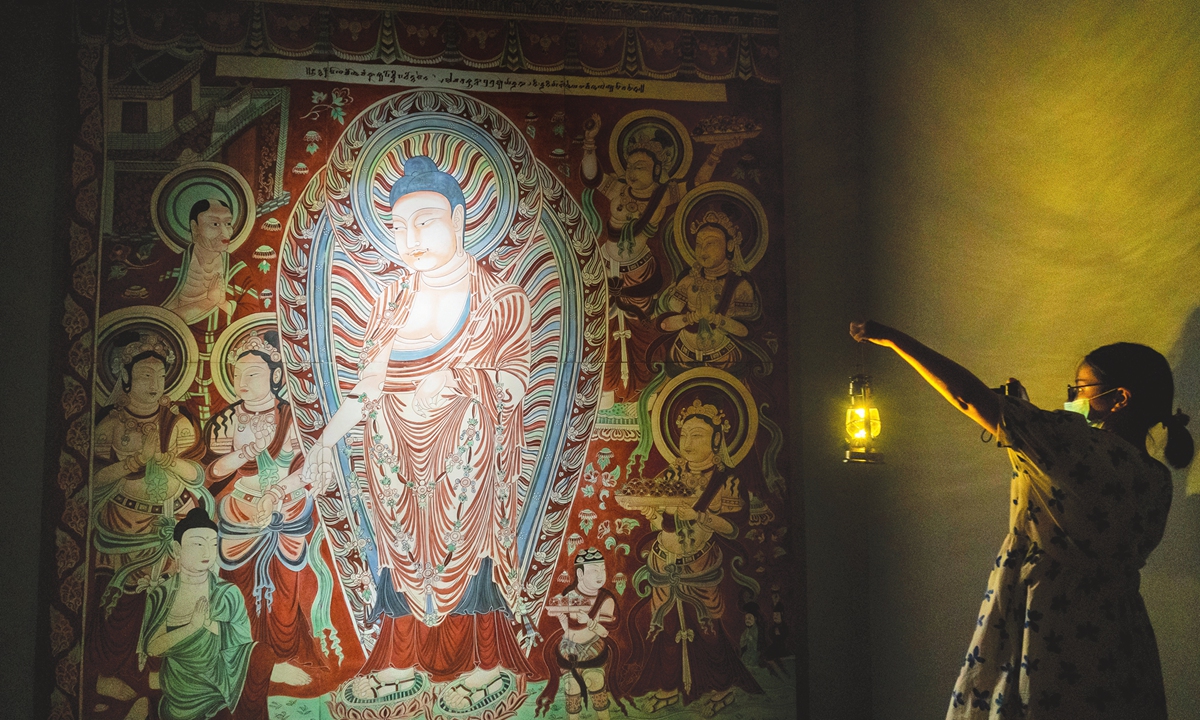Chinese artist offers special art show in Japan
Source: Xinhua Published: 2020/8/6 18:13:42

A visitor looks at a fresco display of a Silk Road-themed exhibition in Shanghai on Tuesday. The exhibition includes carpets and paintings, and it uses photos and multimedia displays to explain the fresco art. Photo: cnsphoto
What does it feel like to insert evergreen pine branches into the bronzes of ancient China's Western Zhou Dynasty (1046-771 BC)? Recently, a special art show is taking place at the Wang Chuanfeng Museum in the Ginza district in downtown Tokyo.
Wang Chuanfeng, a Chinese artist who has been living in Japan for almost 30 years, inserted peony, orchid and pine branches into various bronzes, while Japanese prominent photographer Yoshihiko Ueda used a 50-year-old Deardorff camera to snap photos.
"Wang has his own unique sense of beauty. He creates flower arrangement works from the perspective of oriental art aesthetics, while I use my own aesthetic and intuitive feeling of Japanese culture to photograph the artistic moments," Ueda said.
Wang said they started cooperation three years ago, creating 100 photographs of flower arrangements in 100 bronzes.
"I hope our cooperation can use the present life to awaken the ancient life. Through the fusion of ancient and modern times, history and present, spirit and reality, the audience will experience the fusion and collision of Chinese and Japanese aesthetics," said Wang.
This is not the first time Wang has collaborated with a photographer. Five years ago, he cooperated with celebrated Japanese photographer Kishin Shinoyama to photograph flower arrangements in ancient bamboo baskets in architectural spaces designed by Kengo Kuma, a globally acclaimed architect.
"Most of the baskets used in the last shooting were from Japan, and people felt that there were too many Japanese elements. Therefore, I want to have an artistic cooperation that can fully reflect the Chinese elements. Undoubtedly, bronzes are the most historical and unique wares with Chinese characteristics," said Wang.
Kuma, who watched the shoot at the scene, spoke highly of the collaboration.
"This is a masterpiece of cooperation between the two masters, conveying the eastern aesthetic concept. The sense of beauty is different from Western thinking, which emphasizes that life and art exist separately, but in the eastern Zen world, there is art in life and life in art," he said.
In fact, arranging flowers is just Wang's hobby and his major is painting. The artist is known for his fish paintings, which have appeared on two Japanese stamps and were once used to decorate the Diaoyutai State Guesthouse in Beijing.
Posted in: ART,CULTURE & LEISURE,ARTS FOCUS